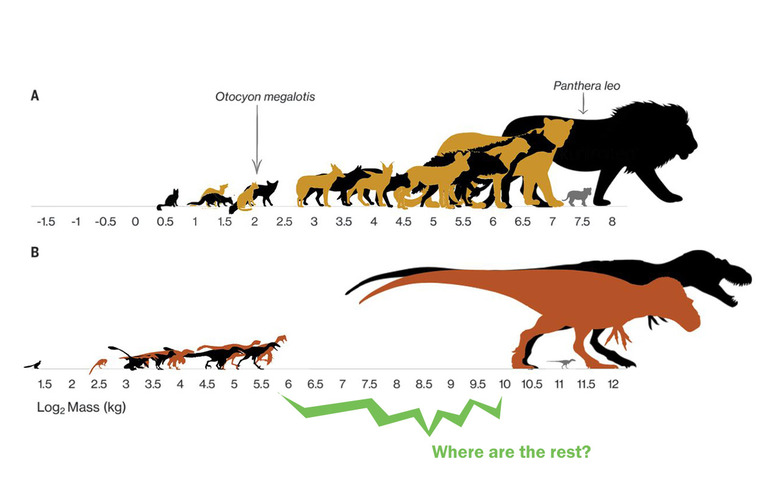Morphospecies Theory Says T-Rex Was King Carnivore At All Stages Of Life
A study released this week shows how the tyrannosaurus consumed different resources at multiple stages of growth. Modern meat-eating mammals can easily be arranged in a chart showing average adult size – each of these animals have a unique effect on their own ecosystem. Given the average size of adult dinosaurs, there appeared to be a massive gap in the middle of the chart from smallest to largest.
A gap exists in the chart of adult meat-eating dinosaurs for each of the three main periods of the Mesozoic. The Triassic, Jurassic, and Cretaceous have a serious lack of medium-sized "meat eating meat-asauruses" (as Ariana Richards' Lex called them in Jurassic Park).
Why in modernity do we have carnivores in a neat range, from small to lion-sized, but back in dinosaur times, we didn't? Researchers From the University of New Mexico and the University of Nebraska proposed a new theory: Morphospecies.

ABOVE: Fig. 3 The dinosaur gap versus modern carnivorous mammals. (A) Carnivorous mammals of Kruger National Park organized to scale by mass. (B) Carnivorous dinosaurs of Dinosaur Park Formation if the largest carnivore were scaled equally to the largest mammalian carnivore in Kruger. Infants (gray) of the largest species shown below adult to show relative growth requirement. IMAGE, DESCRIPTION: UNM Biology Department.
You might've heard about the shift from the old way of thinking about dinosaurs and the new, the shift over the past few decades that reduced the number of individual species of dinosaurs from a lot to... significantly less than previously suspected. If you've never seen the TED Talk with Jack Horner about "Shape-shifting dinosaurs", I suggest you take the time to do so – it's one of the most-watched TED Talks in the history of TED Talks.
Keep this in mind as you read the rest of of the paper published this week by researchers (as outlined above). The old way of thinking about each individual set of bones as a new dinosaur allowed scientists to see a range of dinosaur sizes that was far more "complete", like we see with carnivores in modernity. When people like Jack Horner came around, that theory was shattered.
Now, with this latest research, the morphospecies theory makes sense of the shattered pieces of this puzzle. We don't see individual meat-eating dinosaurs filling every size gap from small to large because dinosaurs like T-rex were there, capitalizing on their entire range of sizes as they grew from tiny baby, just out of an egg, to most massive meat-eater of them all.
Tyrannosaurus was so effective a carnivore that it had a significant impact on the ecosystem in which it lived at every stage of growth. Why have mid-ranged carnivore dinosaurs when you could just have more T-rex?
For more information, take a peek at the paper "The influence of juvenile dinosaurs on community structure and diversity" as published in Science. This paper was authored by Katlin Schroeder, S. Kathleen Lyons, and Felisa A. Smith. Research can be found with code DOI:10.1126/science.abd9220 as published in Science Volume 371, Issue 6532, February 26, 2021.
